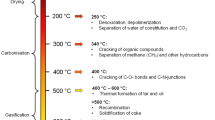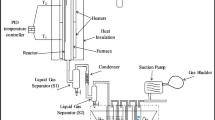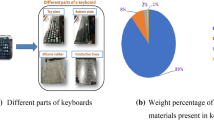Abstract
Greenhouse effect and energy crisis are two major current concerns. The decline in energy sources worldwide is a severe issue and at the same time handling and disposal of solid waste which can become excellent source of energy is another challenging task. In the Municipal Solid Waste (MSW), good quantity of cardboard is observed because normally it is used for packaging purpose and in order to understand its thermal degradation, conversion of it into useful fuel either by gasification or pyrolysis is necessary. Aims of this research are to understand Thermogravimetric Analysis (TGA) of cardboard with heating rate of 5, 10, and 15 °C/min and also ash analysis is conducted at 10 °C/min heating rate using Scanning Electron Microscope (SEM).
Access provided by Autonomous University of Puebla. Download conference paper PDF
Similar content being viewed by others
Keywords
1 Introduction
The waste-to-energy is really a challenging task and to accomplish this task, the pyrolysis is one of the best options. The composition of MSW varies because of socio-economical status of the society, economic development, demographic division, and waste collection potential also for waste-to-energy options. The extensive rises in the MSW generation having severe impact on environment but its disposal associated with social and economic problems.
The pyrolysis having gas, char, and liquid yield products; it means three types of fuels are available. The significance of pyrolysis is also due to the decomposition of polymers into fuels which are not easily degradable and contaminate atmosphere heavily when thrown as a waste at open places. The design of pyrolyzer is based on kinetics studies which correlate the weight degradation with respect to time and temperature; it also represents space or in other words, volume requirement of fuel in the form of pyrolytic products with respect to time temperature. The quantities of yield products are also depends on available space otherwise temperature gradient will exist and conduction losses increase.
Garcia et al. [1] focused kinetics of pyrolysis at different heating rate between 1.5 and 200 °C min−l. After observing the collected results, a theoretical study was carried out in connection with the effect of heating rate and the transmission of heat on the kinetic parameters which can be obtained using the experimental data.
Fontet al. [2] investigated the kinetics of the almond shells impregnated and non-impregnated with CoCl2, polyethylene lignin, and MSW with the help of an analytical pyro probe 1000 or pyroprobe 100, thermogravimetric fluidized sand bed reactor was used to understand the thermal decomposition of heterogeneous materials.
Wu et al. [3] reported kinetic study of painted printed and writing paper by TGA in nitrogen atmosphere for the temperature range is from 450–900 K at 1, 2, and 5 K/min heating rates with two stages of decomposition.
Park et al. [4] suggested a new method for estimation of kinetics constants of low-density polyethylene (LDPE), linear low-density polyethylene (LLDPE), and high-density polyethylene (HDPE), at heating rates of 100 °C/min and 500 °C/min. The numerous analytic methods mentioned were used for comparing with the kinetic parameters estimated from the dynamic method.
Sorum et al. [5] investigated in-depth knowledge of pyrolysis process and estimation of chemical kinetics important constituents of MSW. TGA estimates the kinetic constants which are executed at 100 °C/min heating rate in N2 gas atmosphere. The degradation of hemicellulose, cellulose, and lignin was shown by three autonomous parallel reactions the cellulosic fraction of MSW.
David et al. [6] explained pyrolysis process depending upon the numbers of TGA experimental work on cardboard. The research work includes the determination of kinetics parameters for cardboard. These research works also focus pyrolysis process with the support of numbers of TGA experimental works also compare the results of graphical method with numerical results which are in good level of satisfaction.
Molto et al. [7] focused on kinetic studies for the decomposition of used cotton fabrics and for explaining the behavior of decomposition all the runs were performed and have been proposed and tested. In the pyrolysis of the used cotton fabric waste, the model comprises two parallel reactions during decomposition.
Miranda et al. [8] studied thermal degradation behavior of textile waste by TGA at different heating rates also decomposition was studied by semi-batch pyrolysis process.
The DTG curves show three peaks; two out of which were hemicellulose and cellulose and one might be due to decomposition synthetic polymer. The major research in present work focuses on thermal degradation behavior of cardboard waste at 5, 10, and 15 °C/min heating rate and also ash obtained during decomposition of cardboard analyzed using Scanning Electron Microscope (SEM).
2 Experimental Methodology
2.1 Material
The experiments were conducted on cardboard collected from waste packing boxes which was sheared into small pieces of 1–2 mm by using scissors. The size of the particle used in TGA having micro-weight and sample amount limitation of container. Table 1 indicates proximate, ultimate result, and HHV of cardboard.
2.2 Thermogravimetric Analysis (TGA)
The engineering design of modern pyrolysis reactors and gasifiers requires a deep knowledge of kinetics studies for different MSW constituents at different temperature ranges and heating rates. The TGA and DTG were performed in TG/DTG system. Samples’ temperature range varies from room temperature (RT) to 600 °C with 5, 10, and 15 °C/min heating rate in nitrogen atmosphere and flow rate of gas was 50 ml/min. The sample size of cardboard was taken as 6 mg. Samples were placed in platinum container and reference used was α alumina.
3 Kinetics
It is necessary to understand the reaction mechanism of pyrolysis for obtaining the reactions with respect to its kinetic parameters. The heated deterioration of MSW constituents is explained to be proceeding through many complicated reactions [5, 6, 8].
A method was formulated to calculate activation energy from single dynamic TGA data employing following model [10, 11].
Here F062 is heating rate, E is activation energy A is pre-exponential or frequency factor, R is universal gas constant (8.314 kJ mol−1 K−1).
This equation has no exact solution; hence, different approximations have been done by Flynn wall Ozawa method [12].
For cardboard decomposition, in case TGA, the Flynn wall Ozawa [12] method used for activation energy for three heating rates are used.
4 Results and Discussion
Figure 1 represents Thermogravimetric curves of cardboard at 5, 10, and 15 0C/min heating rates, respectively, while Fig. 2 represents the corresponding Differential Thermogravimetric curves for same heating rates.
The decomposition is observed in three stages as shown in Figs. 1 and 2. In first stage, moisture present in sample gets removed and hemicellulose gets decomposed. The degradation rate in first stage is slow due to low temperature range and mass transfer resistance [1, 5, 6, 8]. The degradation of cellulose and lignin occurs in second and third stage, respectively. The similar results are reported by Sorum et al. [5], David et al. [6], Miranda et al. [8] and which substantiates the present work.
Figure 1 represents same TG curves pattern for heating rates 5, 10, and 15 °C/min; however, rates and kinetics parameters are differing. During second stage, degradation occurred is faster because cellulose gets decomposed compared to first and third stage where hemicellulose and lignin are decomposed, respectively, as heating rate increases which is represented by TG curves in Fig. 1 [5]. The loss in weight escalates in all three phases at a quicker amount as heating rate rises which is quite obvious that heating rate enhances the values of kinetics parameters too. In connection to three stages of decomposition on the TG curves correspondingly, three peaks are noticed on the DTG curves. DTG curves show as heating rates expand there will be a lateral shift toward greater temperatures and which may be the united effects of the heat transfer at various heating rates and resulting in delayed the decomposition as stated by Sorum et al. [5]. Figure 1 reports that rise in heating rate gives the greater value of activation energy, which can be attributed to the formation of active molecules also enhances in molecular collision at high heating rates [5, 8]. It also shows that the activation energy value is maximum in second stage in comparison to other two stages in all cases all heating rates. During third phase of decomposition, activation energy value gets lowered because of low deterioration rate. It is observed that amount of decaying rises with the rise in heating rate and a declination is observed in total decaying. It is because of the inadequate decaying time for concluding reaction with rising heating rates [8]. In case of all cellulosic fractions, the major weight loss occurs between the temperatures ranges of 250–400 °C as also reported by Sorum et al. [5].
Figure 2 represents the DTG curves which are nothing but decomposition rate with respect to temperature in association with 5, 10, and 15 °C/min heating rates. Results show that rise in heating rate leads to rise in weight loss and corresponding maximum temperature also increases linearly due to delay in decaying which penetrates extra heat into the specimen for shorter while [5]. In case of cardboard, the three peaks are commonly observed and the temperature range in which maximum peak can be observed varies from 175 to 250 °C, 300 to 425 °C, and 450 to 525 °C which corresponding to hemicellulose, cellulose, and lignin, respectively [5, 6].
The description of less marked shoulder on the DTG curves for hemicellulose in case of cardboard is due to the minor content of hemicellulose and/or catalytic effects. Catalytic effects generated by inorganic species such as ash and in the case of cardboard, residues from sulfate process causes the decaying of cellulose to occur at reduced temperature [5].
Tables 2 and 3 present the values of decomposition with temperature range and kinetic constants for different stages of decomposition, respectively.
The elemental analysis of residues of lignocellulosic waste material, i.e., cardboard is performed with the help of SEM using Energy Dispersive Spectroscopy (EDS) technique. EDS is a scientific approach and it employs x-rays that are transmitted from the sample when blasted by the electron beam for identifying the elemental composition of the sample. The elemental analysis of residue with the help of scanning electron microscope at 10 °C/min of heating rate has been carried out. The importance of this study is to explore products and elements presence in the residues of cardboard [13]. Figures 3 and 4 indicate elemental analysis of cardboard ash obtained from TGA at 10 °C/min of heating rate.
5 Conclusion
For cardboard material, decomposition occurs in three stages. Stage I, II, and III represents decomposition of hemicellulose, cellulose, and lignin, respectively. The estimation of decomposition rate is possible through the assurance of kinetic parameters such as activation energy.
The activation energy for cardboard waste at the heating rate of 5 °C/min to 15 °C.
/min is obtained as 128.15 kJ/mol in first stage, 133.65 kJ/mol in second stage and 83.74 kJ/mol in third stage, respectively.
The significance of elemental analysis is to know the possible elements existing in the residue and how they will affect the environment from pollution point of view in later stage.
6 Future Scope of Work
The present research work can be extended for development of such reactor at macro-level of cardboard or any MSW constituents for various heating rate makes possible. It also yields products obtained by such reactor which establishes MSW as an alternative better fuel.
References
Garcia AN, Marcilla A, Font R (1995) Thermogravimetric kinetic study of the pyrolysis of mu- nicipal solid waste. Thermochim Acta 254:277–304
Font R, Marcilla A, Garcia AN, Caballero JA, Conesa JA (1995) Comparison between the pyrolysis products obtained from different organic wastes at high temperatures. J Anal Appl Pyrol 32:41–49
Wu C-H, Chang C-Y, Lin J-P, Hwang J- Y (1997) Pyrolysis kinetics of paper mixture in municipal solid waste. Fuel 76:115l–1157
Park IW, Sea Cheon O, Lee HP, Taik Kim H, Yoo KO (2000) A kinetic analysis of thermal degradation of polymers using a dynamic method. Polym Degrad Stabil 67:535–540
Sorum L, Gronli MG, Hustad JE (2001) Pyrolysis characteristics and kinetics of municipal solid waste. Fuel 80:1217–1227
David C, Salvador S, Dirion JLM (2007) Determination of a reaction scheme for cardboard thermal degradation using thermal gravimetric analysis. J Anal Appl Pyrolysis 67:307–323
Molto J,Font R, Conesa A, Martı´n-Gullo´n I (2005) Thermogravimetric analysis during the decomposition of cotton fabrics in an inert and air environment. J Anal Appl Pyrolysis (Article in Press)
Miranda R, Sosa_Blanco C,Bustos-Martı ´nez D, Vasile C (2007) Pyrolysis of textile wastes kinetics and yields. J Anal Appl Pyrolysis 80:489–495
Buah WK, Cunliffe AM, Williams PT (2007) Characterization of products from the py- rolysis of MSW. Process Saf Environ Prot 85:450–457
Yourlmaz S (2006) Investigation of emissions and combustion kinetics of waste wood samples with thermal and spectral methods. PG Dissertation, Middle East Technical University, Beirut
Liu Z (1998) Handbook of thermal analysis. John willy & Sons, pp 47–48
Flynn JH, Wall LA (1966) Polym Sci Part B, Polymer Letters 4:323
Miskolczi N, Angyal A, Bartha L, Valkai I (2009) Fuels by pyrolysis of waste plastics from agricultural and packaging sectors in a pilot scale reactor. Fuel Process Technol 90:1032–1040
Author information
Authors and Affiliations
Corresponding author
Editor information
Editors and Affiliations
Rights and permissions
Copyright information
© 2021 Springer Nature Singapore Pte Ltd.
About this paper
Cite this paper
Singh, S.K., Namjoshi, S.A. (2021). Evaluation of Thermal Degradation Behavior of Cardboard Waste. In: Shorif Uddin, M., Sharma, A., Agarwal, K.L., Saraswat, M. (eds) Intelligent Energy Management Technologies. Algorithms for Intelligent Systems. Springer, Singapore. https://doi.org/10.1007/978-981-15-8820-4_4
Download citation
DOI: https://doi.org/10.1007/978-981-15-8820-4_4
Published:
Publisher Name: Springer, Singapore
Print ISBN: 978-981-15-8819-8
Online ISBN: 978-981-15-8820-4
eBook Packages: EngineeringEngineering (R0)








